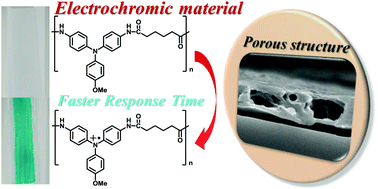A facile approach to prepare porous polyamide films with enhanced electrochromic performance†
Abstract
Novel electroactive triphenylamine-based polyamide (PA) films with a purposeful porous structure have been designed and prepared by a simple route. Polymer thin films containing well dispersed electrolyte salts were prepared first, then channels of pores could be generated within the polymer film by washing the salts out. With the help of the porous channels, the diffusion rate between electroactive species and the electrolyte during the electrochemical process could be effectively increased. Consequently, the driving potential and electrochromic response time can be efficiently improved through this approach. Novel porous PA films with optimal results both in optical transparency and electrochemical properties could be readily obtained by choosing a commonly used supporting electrolyte TBABF4 as a salt in this study. When the PA films containing un-washed TBABF4 salt were further assembled into electrochromic devices (ECDs), the salt could then be leached out during the electrochemical redox switching process to form a porous film structure and also serves as a supporting electrolyte in ECDs simultaneously. Therefore, EC performance such as the driving potential and response time could be enhanced obviously by this simplified fabrication procedure of ECDs.



 Please wait while we load your content...
Please wait while we load your content...